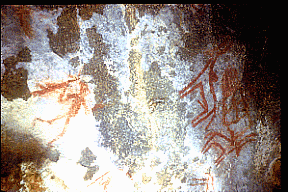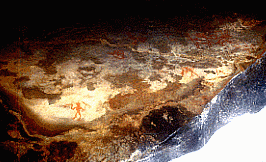PREHISTORIC ROCK CARVINGS NEAR HYDERABAD, INDIA
Culture series..by V Ramchandra Rao
A prehistoric cult spot dating back to 'neolithic' times was discovered recently near Patancheru (80 km from Hyderabad) by the late Mr. Narahari of the state Archeology department. The archeologists examined the site which has some cave paintings in red ochre and rock carvings. The results of the trial excavations tentatively placed the site between the mesolithic and megalithic periods, that is the 'neolithic'. The site of Edithanur, Medak district, thus falls between 2300 BC and 900 BC. After this date "megalithic" culture makes its appearance in south india.
 At the village of Edithanur, there is a sprawling hillock of boulders , very common in these parts. At present there is a small medieval shrine of a mother Goddess in a niche formed by the tumbled boulders. Inside, a narrow passage leads straight up six metres to an enclosed space surrounded by the big stone boulders. There is a ridge like rock in the middle of the "room". All the boulders and walls are rough, except the rounded ridge. It is very, very smooth .You can climb on to it easily , as if onto the back of a large bull .
At the village of Edithanur, there is a sprawling hillock of boulders , very common in these parts. At present there is a small medieval shrine of a mother Goddess in a niche formed by the tumbled boulders. Inside, a narrow passage leads straight up six metres to an enclosed space surrounded by the big stone boulders. There is a ridge like rock in the middle of the "room". All the boulders and walls are rough, except the rounded ridge. It is very, very smooth .You can climb on to it easily , as if onto the back of a large bull .
 The puzzle clears, as our eyes adjust to the darkness.There, right in front of us, the front "wall" takes on a new meaning.
The puzzle clears, as our eyes adjust to the darkness.There, right in front of us, the front "wall" takes on a new meaning.
There is a prehistoric hunting scene scratched laboriously into the rock. Two huge bulls are surrounded by milling men engaged in a hunt. The large bull in the foreground is most realistically carved, with its long curving horns raised high. The men are drawn like stick figures, and appear to be attacking it from all sides, using spears and javelins. The depiction of the bull is identical to those found in neolithic settings at Tekkalakota and other places , on pottery. Some say it is a baby elephant, not a bull.
On the side walls of the chamber are other relief figures. Another stick figure of a man, accompanied by a dog ,and spear. A group of wavy lines and circles on the other side -- fish in a river or mother goddess?--we can't be sure.
Why was the ridge in front of the big carving so smooth ? I think it became smooth over the centuries, with people coming and sitting here for some rites . Possibly this was a place where initiation ceremonies were performed, like in tribal societies : or annually some rites were performed after the harvest .
Close by, high on the slopes, is a ridge of overhanging rock. Sitting here, you can get a fine view of the plain below. Excellent lookout for a shepherd or cowherd --or even a hunter. On the ceiling, there are paintings in red ochre. These are very old, and have been preserved because a film of carbonate seems to have covered them naturally. Here too, cattle seems to have been the main interest in the lives of the painters. There are several drawings of cows, bulls and calves. A man is attempting to snare a bird. Another man is about to fling a javelin --just like in the Olympics --and another man holds a forked stick . Antelopes scamper around, and there seem to be small animals, calves or dogs gambolling all over the place. Below the ridge archeologists found small stone tools called microliths . (They need not be connected to the paintings).
In the exploratory trenches archeologists found bits of neolithic pottery and small round stone tools called dabbers or burnishers. They are supposed to have been used to smooth pottery ,or maybe skins of animals while tanning. They could also be used as grinders of powders in a later date.
Around the hill there is a niche in the rock called Siddhula Gutta. Folk tradition of the area says holy men, alchemists and healers, of ancient times called Siddhas lived in the cave. These are much more recent. The Buddhist philosopher Nagarjuna was also an acccomplished alchemist.
On the reverse slopes of the hill, five wild brown mongooses peer questioningly , decide they disapprove of us, and scamper away in disdain. They disappear in a second into the innumerable crannies between the rounded boulders. Wonder what hidden places they must know of ? Apparently there are similar other sites close by but the villagers are not forthcoming about their location, as accidents and something happened in the past. There is an air of "voodoo" still about the place.
Since these are among the earliest glimpses of art in Andhra Pradesh , they are very significant. But what of the people who painted them ? Nothing certain can be said at the state of our present knowledge except they were in a neolithic/chalcolithic state.. But informed speculation is allowed... since the people seem to be preoccupied with cattle and hunting, they were probably just shifting from pastoral herdkeeping to settled agriculture. Similar motifs are found throughout the Deccan in Karnataka also , and Rayalseema. Hence it could be the population was fairly numerous, and have left descendants. An archeologist who ecavated several neolithic sites elsewhere opined the people seemed to be "very primitive" physically, resembling some tribal folk of today. Most probably they could have been the ancestors of the tribal Indian people of today.
© by v ramchandra rao email: vramrao@yahoo
back to culture pages index
 At the village of Edithanur, there is a sprawling hillock of boulders , very common in these parts. At present there is a small medieval shrine of a mother Goddess in a niche formed by the tumbled boulders. Inside, a narrow passage leads straight up six metres to an enclosed space surrounded by the big stone boulders. There is a ridge like rock in the middle of the "room". All the boulders and walls are rough, except the rounded ridge. It is very, very smooth .You can climb on to it easily , as if onto the back of a large bull .
At the village of Edithanur, there is a sprawling hillock of boulders , very common in these parts. At present there is a small medieval shrine of a mother Goddess in a niche formed by the tumbled boulders. Inside, a narrow passage leads straight up six metres to an enclosed space surrounded by the big stone boulders. There is a ridge like rock in the middle of the "room". All the boulders and walls are rough, except the rounded ridge. It is very, very smooth .You can climb on to it easily , as if onto the back of a large bull . The puzzle clears, as our eyes adjust to the darkness.There, right in front of us, the front "wall" takes on a new meaning.
The puzzle clears, as our eyes adjust to the darkness.There, right in front of us, the front "wall" takes on a new meaning.